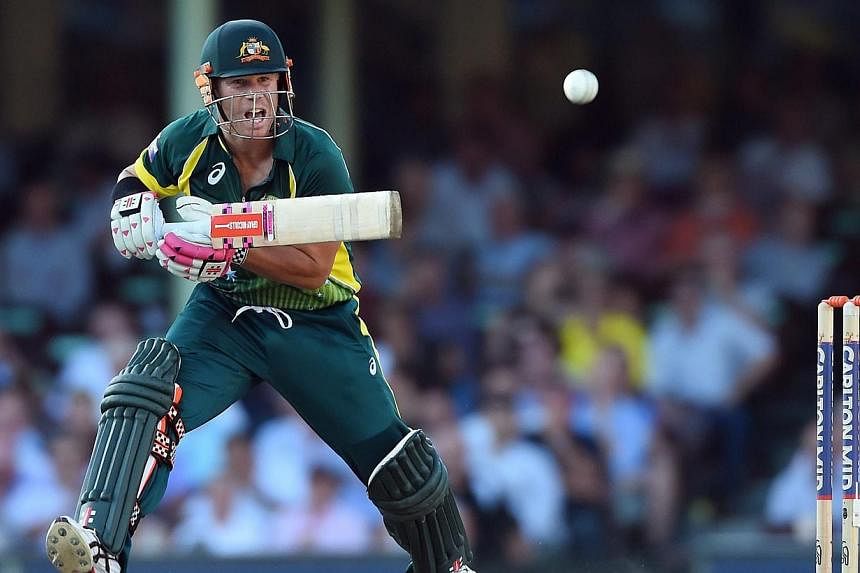THERE'S just one problem with the call this week to introduce football's system of yellow and red cards to cricket. It would be a classic case of overkill.
The suggestion to use cards to curb loutish behaviour comes from former New Zealand Test captain Martin Crowe, now 52 and one of the best-credentialled cricketers of his generation.
His recommendation is that two yellow cards "should result in a red card", which in turn would lead to an offender being suspended from the game for six months.
It's an interesting proposal, but let's have a close look at whether or not the issue is deeply entrenched in international cricket or not. Tempers always get frayed on the field, but this season most of the focus has been squarely on one repeat offender - Australia's David Warner.
Surely the sport doesn't need a new law just to curb one man.
Were the problem widespread throughout every team in world cricket and common throughout all three forms of the game, I would heartily endorse the introduction of cards. But ushering in yellow and red cards now would be a knee-jerk reaction in a sport that has been played internationally since 1877.
Back then, it was genteel and played by amateurs, but today's highly-paid professionals have taken the sport - and its intensity - to ever-higher levels. That in itself is reason to demand acceptable behaviour.
Enforcing discipline in cricket is a matter of escalation. If a captain and team management cannot control a player, then the national selectors should warn him. Failing that, the national board - as it has in Warner's case - must step in to solve the problem.
Remember, too, that umpires and match referees have certain powers as well and the International Cricket Council (ICC), the game's peak body, is reportedly keen to see umpires rein in offenders.
While the ICC certainly has the right to introduce a card system, doing so at this stage would bring an Orwellian touch of Big Brother to the game. Furthermore, this would suggest that the ICC has no confidence in the ability of national boards or ICC-appointed match officials to keep players in line.
There is a very fine line between acceptable aggression and boorish behaviour and Warner's judgment errs consistently on just where that crucial delineation should be.
His rap sheet is growing steadily. He has played an unsavoury role in a string of on-field infractions during India's tour of Australia, the most recent of which took place during Sunday's limited-over game against India, when he told batsman Rohit Sharma to "speak English".
The next day, Warner was hauled up to face James Sutherland, the CEO of Cricket Australia, who warned him about his ongoing behaviour. In addition, he was fined a tad more than $3,000 - half his match fee - by the International Cricket Council (ICC), the governing body of world cricket.
Two years ago, Warner was dropped from the Australian side after he punched England cricketer Joe Root in a bar. And it is precisely this side of the fractious batsman's behaviour that Crowe wants to curb, because he does not want to see a punch being thrown during an international cricket match.
On this point, I could not agree more with Crowe. Having covered international cricket at some of the game's most hallowed venues, I concur that there is no place for any vestige of physical contact.
The closest I ever saw two opponents almost come to blows was during the Perth Test between Pakistan and Australia in November 1981, when two supremely talented but fiery cricketers clashed.
After Australian fast bowler Dennis Lillee and Pakistan captain Javed Miandad made physical contact on the pitch, Miandad raised his bat as if to strike the paceman.
One of the ugliest photographs in the annals of cricket shows umpire Tony Crafter standing between the two men whose body language indicates a willingness to trade blows. Miandad's bat is positioned to take a swipe at Lillee, who in turn has his fists cocked.
Nothing I've ever seen in the ensuing years has even come close to that level of overt physicality.
Not even during the 1993-94 Australian tour of South Africa, when fast bowler Merv Hughes strode down the pitch to confront South African captain Hansie Cronje.
Hughes had been carted around the ground by a rampant Cronje and it seemed that something significant was about to unfold. Instead, Hughes, with his concrete-block build, tough demeanour and thick bushranger moustache, approached his opponent only to pass wind with great gusto while saying: "Try hitting that for six".
There are no such quips from Warner, just a desire to push the behavioural boundaries constantly. It is unpleasant to see that Warner, practically single-handedly, has now put the authorities on notice with the World Cup about to begin.
No one wants to see the ICC step in and don the uniform of the morality police just to curb one man. The Warner brand of bile is not systemic, thank goodness, but Australia must ensure that Warner either toes the line or pays the price.
Warner was not even born when the Lillee-Miandad incident took place, but perhaps he should seek out that dire photograph or even the inevitable clip on YouTube to see just how close Test cricket teetered on the brink of violence.
Then perhaps he will realise that he should zip his lip, keep his fists to himself and concentrate on becoming a better cricketer and a better man. If he can steer himself away from fisticuffs, the entire cricketing world will be as pleased as, er, punch.


